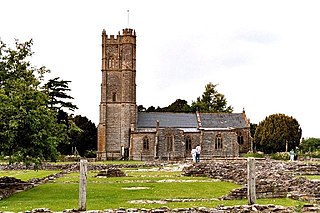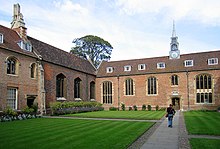
Battle Abbey is a partially ruined Benedictine abbey in Battle, East Sussex, England. The abbey was built on the site of the Battle of Hastings and dedicated to St Martin of Tours. It is a Scheduled Monument.

Crowland or Croyland is a town in the South Holland district of Lincolnshire, England. It is situated between Peterborough and Spalding. Crowland contains two sites of historical interest, Crowland Abbey and Trinity Bridge.

Buckfast Abbey forms part of an active Benedictine monastery at Buckfast, near Buckfastleigh, Devon, England. Buckfast first became home to an abbey in 1018. The first Benedictine abbey was followed by a Savignac abbey constructed on the site of the current abbey in 1134. The monastery was surrendered for dissolution in 1539, with the monastic buildings stripped and left as ruins, before being finally demolished. The former abbey site was used as a quarry, and later became home to a Gothic mansion house.

St Benet's Hall is a Permanent Private Hall (PPH) of the University of Oxford. Its principal building is located at the northern end of St Giles' on its western side, close to the junction with Woodstock Road, Oxford. Established in 1897 by Ampleforth Abbey, St Benet's Hall original historic function was to allow its monks to be able to study for secular degrees at the university. The hall historically has a Benedictine and Roman Catholic ethos. Today, St Benet's Hall hosts an international community consisting of 79 undergraduate students and 44 graduate students of all faiths and none. Unlike other Colleges, St Benet's Hall does not have a High Table, but one Common Table which is shared by all members of the Hall.

Ramsey Abbey was a Benedictine abbey in Ramsey, Huntingdonshire, England. It was founded about AD 969 and dissolved on 22 November 1539.

Magdalene College is a constituent college of the University of Cambridge. The college was founded in 1428 as a Benedictine hostel, in time coming to be known as Buckingham College, before being refounded in 1542 as the College of St Mary Magdalene. Magdalene counted some of the greatest men in the realm among its benefactors, including Britain's premier noble the Duke of Norfolk, the Duke of Buckingham and Lord Chief Justice Christopher Wray. Thomas Audley, Lord Chancellor under Henry VIII, was responsible for the refoundation of the college and also established its motto—garde ta foy. Audley's successors in the Mastership and as benefactors of the College were, however, prone to dire ends; several benefactors were arraigned at various stages on charges of high treason and executed.

The Abbey Church of Saint Peter and Saint Paul, Shrewsbury is an ancient foundation in Shrewsbury, the county town of Shropshire, England.

Thomas Audley, 1st Baron Audley of Walden KG, PC, KS, was an English barrister and judge who served as Lord Chancellor of England from 1533 to 1544.

New Norcia is a town in Western Australia, 132 km (82 mi) north of Perth, near the Great Northern Highway. It is situated next to the banks of the Moore River, in the Shire of Victoria Plains.

Abbotsbury Abbey, dedicated to Saint Peter, was a Benedictine monastery in the village of Abbotsbury in Dorset, England. The abbey was founded in the 11th century by King Cnut's thegn Orc and his wife Tola, who handsomely endowed the monastery with lands in the area. The abbey prospered and became a local centre of power, controlling eight manor houses and villages. During the later Middle Ages, the abbey suffered much misfortune. In the time of the dissolution of the monasteries, the last abbot surrendered the abbey and the site became the property of Sir Giles Strangways.

Crowland Abbey is a Church of England parish church, formerly part of a Benedictine abbey church, in Crowland in the English county of Lincolnshire. It is a Grade I listed building.

Thorney Abbey, now the Church of St Mary and St Botolph, was a medieval monastic house established on the island of Thorney in The Fens of Cambridgeshire, England.

Muchelney Abbey is an English Heritage property in the village of Muchelney in the Somerset Levels, England. The site consists of ruined walls showing the layout of the abbey buildings constructed from the 7th to 16th and the remaining intact Abbott's House. It is next to the parish church in which some of the fabric of the abbey has been reused.

Kingswood Abbey was a Cistercian abbey, located in the village of Kingswood near Wotton-under-Edge, Gloucestershire, England. The abbey was demolished during the Dissolution of the Monasteries, and all that remains is the gatehouse, a Grade 1 listed building. Through the gatehouse arch are a few houses and the small village primary school of Kingswood.

Gloucester College, Oxford, was a Benedictine institution of the University of Oxford in Oxford, England, from the late 13th century until the Dissolution of the monasteries in the 16th century. It was never a typical college of the University, in that there was an internal division in the college, by staircase units, into parts where the monasteries sending monks had effective authority. The overall head was a Prior.

St John's Abbey, also called Colchester Abbey, was a Benedictine monastic institution in Colchester, Essex, founded in 1095. It was dissolved in 1539. Most of the abbey buildings were subsequently demolished to construct a large private house on the site, which was itself destroyed in fighting during the 1648 siege of Colchester. The only substantial remnant is the elaborate gatehouse, while the foundations of the abbey church were only rediscovered in 2010.
The Abbot of Crowland was the head of Crowland Abbey, an English monastery built up around the shrine of Saint Guthlac of Crowland by King Æthelbald of Mercia, and refounded as a Benedictine house circa 948. The last abbot was John Wells, who was constrained to surrender the monastery to the king's agents during the Dissolution of the Monasteries in 1539.
John Chambers was an English Benedictine, the last Abbot of Peterborough and first Bishop of Peterborough.

Goldcliff Priory was a Benedictine monastery in Goldcliff, Newport, South Wales, founded in 1113 by Robert de Chandos and subject to the Abbey of Bec in Normandy. The priory was situated on the site now occupied by Hill Farm, to the south of the current farmhouse, on the prominent knoll of high ground next to the sea. As late as the 1950s Hando remarked that outlines of buildings which were probably part of the priory could still be seen in grass patterns or crop marks at certain times of the year. By the 1970s the only remaining physical remnant of the priory was to be found as part of a cellar in the farm house.

St. Mary Magdalen was a Benedictine priory in Lincoln, England. Along with Sandtoft Priory and Hanes Cell, it was a Lincolnshire cell of St Mary's Abbey in York, England. A surviving building, once owned by the priory, is Monks' Abbey, Lincoln.


















